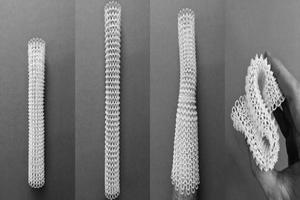
Digital Interlooping: how 3D printing and textiles are becoming closely knit
YarnsandFibers News Bureau 2019-03-20 16:32:00 – UKMark Beecroft, a researcher from the Manchester Metropolitan University, believes that the future of textiles will be closely intertwined with 3D printing. Not only does he believe it—he is actually paving the way for it in an innovative additive manufacturing-based project called Digital Interlooping.
Conducted at the Manchester School of Art in the UK, Beecroft’s research has demonstrated the ability to 3D print a knitted structure using selective laser sintering (SLS) and nylon. The production method used in the project could, in the future, be used in the apparel and textile industries for customized manufacturing or specific application garments.
The test pieces 3D printed by Beecroft consist of tube-shaped knitted structures inspired by traditional knitting patterns. The tubular, seamless structures, made from nylon powder, have demonstrated excellent strength, stability and elasticity in post-printing tests. These properties could be beneficial in the sportswear or medical apparel sectors, where stretch and compression are needed.
“The results show that it is possible to print these flexible, tubular textile-based structures at various scales with the use of nylon,†explained Beecroft, who is a senior lecturer in Textiles Practice at the Manchester School of Art. “This research potentially provides an opportunity for a new method of textile production that could be ground-breaking for apparel-related industries as combined with 3D body scanning it could offer the opportunity for bespoke, custom fit textiles, that can be created much easier than other methods.â€
After the selective laser sintering process—in which a laser sintered the structure from a bed of powdered nylon—the 3D printed textile showcased very good recovery after compression and stretching as well as excellent flexibility. With the research project off to a promising start, Beecroft will continue to explore the use of SLS for 3D printing knit textiles and will even look into using other flexible materials such as TPU.
“This study is really promising as we now know that SLS is a suitable manufacturing process to achieve these knit structures,†he said. “Further research into other flexible powder material such as TPU (thermoplastic polyurethane) would also now be of interest to test the mechanical behaviour of the material, in combination with the knitted structure to compare the results with nylon.â€
Currently, Beecroft is conducting more tests on his seamless 3D printed knits, including strength, elongation and load to breaking point tests.
Market Intelligence
Ask for free sample Report

experience
Customer Base
dedicated team
Countries Served Worldwide









